Wednesday 24th September 2025, Broncroft Lodge Farm
Broncroft Lodge Farm is an organic farm located close to the village of Broncroft in Corvedale bordering the River Corve.
We parked in the farmyard, where we were met by the farmer who then guided us though a field containing a very docile cow and three calves, only the smallest calf showed any interest in us, into a grassland field by the river.
Neighbouring this field was an enclosure in which a pool was situated.
This looked an interesting area, but it was patrolled by some cattle.
Apparently, these were not the farmer’s cattle, but had invaded the site, having forded the river, from a neighbouring farm.
Most of us stayed in the field, but a couple did brave the cattle to take a look at the pool.
In the field our interest was mainly in the marginal vegetation, but a woodpile attracted attention for a while.
Initial suction sampling of the field and marginal vegetation revealed a pair of Meadow laybirds, Rhyzobius litura;
A Red-rumped ladybird, Scymnus haemorrhoidalis;
And a Lucerne Flea, Sminthurus viridis.
A Lucerne Flea is not a flea!
It is a species of springtail. I assume it got its name from the fact it is mainly associated with clovers and lucerne on which it feeds…
And it is small…
And jumps.
At this time of year, you will often find bulgy swellings in the stems of creeping thistle.
These are galls caused by the larvae of the fly Urophora cardui. Eggs are laid by the fly onto the stem of the plant. On hatching the larvae burrow into the stem to feed causing the gall.
Shouts of encouragement and frustration in equal measure were heard from neighbouring fields as the invaders were marshalled back to their rightful place. After a while only birdcalls and the sound of suction samplers disturbed the peace.
Walking around the field edge we eventually got a glimpse of the River Corve.
It is not easy to see, but the black blob in the photograph is the shaded water of the river!
Other finds around this time were:
A Knot Grass moth larva, Acronicta rumicis;
A leaf beetle, Chrysolina polita;
A number of small, globular galls on an alder leaf caused by the mite, Aceria nalepai;
And a collection of pimple galls on a field maple leaf, also caused by a mite, Aceria myriadeum.
Now that the invading cattle had been returned to their home, we could easily access the pool and, just as importantly, the picnic table which was an inviting spot to have lunch.
As we made our way to lunch we spotted a harvestman, Dicranopalpus ramosus agg.
And a Red Marsh Ladybird, Coccidula rufa.
Lunch over we spent time exploring the vegetation for invertebrates around the pool…
And in it!
Very, very carefully!!!
This was found.
This is a River Skater, Aquarius najas.
(I am not sure if it was extracted from the pool of the small stream that ran close-by.)
Other invertebrates observed in and around the pool were a female Brown hawker, Aeshna grandis, that was ovipositing;
A pair of Common darters, Sympetrum striolatum, captured in flight;
And a weevil, Leiosoma deflexum.
Time to move on.
But where should we go.
A quick consultation with the map of the farm suggested visiting an area marked as swamp.
Unfortunately, it was at the far western border of the farm.
Was it too far?
Probably.
But we rose to the challenge…
Some of us did!
The first obstacle was a small stream that cut off the most direct access. We had no alternative but to return to the start (thankfully, the cow and calves ignored us)…
Cross a bridge…
And then follow the track that led most of the way to the swamp.
On the way we spotted a Slender Groundhopper, Tetrix subulata;
A Copper Greenclock beetle, Poecilus cupreus;
And tucked into the hedge, a Spindle, Euonymus europaeus, given away by its brightly coloured fruits.
We marched on.
Pausing every now and then to check where we were and that we were going in the right direction.
And, of course, keeping an eye out for things of interest.
An amazing sight greeted us when a clump of grass at the side of the track was beaten, and 16-spot ladybirds rained into the waiting tray like hundreds and thousands being sprinkled onto the top of your ice-cream.
The assumption made was that this was an aggregation of the species preparing to overwinter.
A couple of other beetles also turned up.
A leaf beetle, Chrysolina oricalcia;
And a Vine Weevil, Otiorhynchus sulcatus.
Finally we arrived.
Only to find the “swamp”, although it looking promising from the outside, was impenetrable.
There was nothing we could do but return from whence we had come, intercepting stragglers as we went.
Passing a hedge covered in ivy we paused to check for Ivy Bees, but none were found. We did, however, observe a male Hornet, Vespa crabro feeding.
As always seems to be the case, the walk back felt much quicker than the walk there.
And the sun came out, at the end of a cloudy afternoon, to illuminate Brown Clee in the distance.
I have not been sent a “Weevil of the Week” for this outing, so I am nominating this one, Rhinocyllus conicus, which, according to the photographer, is described in the literature as being like a “bedraggled sheep”.
He adds “A bit like we were at Treflach Farm”!!
My thanks to the owners for inviting us to visit and do what we enjoy doing, and to the photographers for their excellent images.



































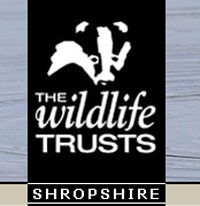

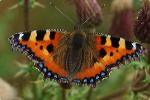




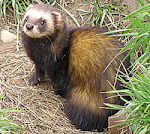

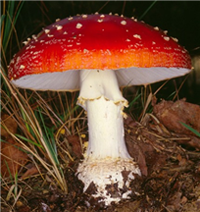





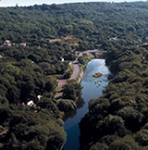






Your 'Field Maple" is Alder!!
ReplyDelete